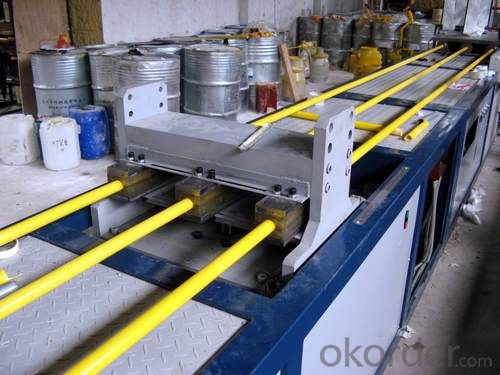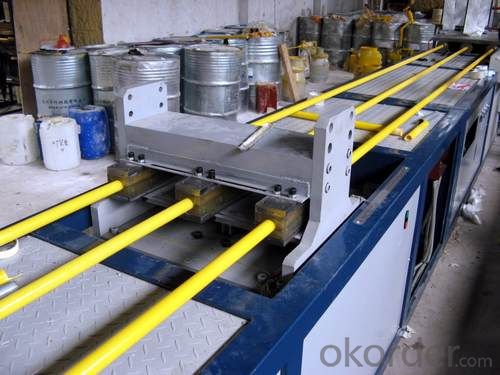FRP Rebar-Reinforce Fiber Glass
- Loading Port:
- Shanghai
- Payment Terms:
- TT or LC
- Min Order Qty:
- -
- Supply Capability:
- 50000 m.t./month
OKorder Service Pledge
OKorder Financial Service
You Might Also Like
1.Brief Introduction
GFRP Rebar,FRP Rebar,GRP Rebar,glass fiber reinforced polymer rebar,low-weight rebar,all-thread rebar,anti-static rebar.

2.Characteristics
(1)All-Thread FRP Bolt: The rod is threaded over the whole length, i.e. "All-Thread";
(2)High Corrosion Resistance: The base materials used by the bolt are durable materials, and they are molded through the composite process. The life span is up to 100 years. They can be used as permanent support materials;
(3)High Tensile Strength: The load is approximately double that of a steel bar with the same diameter;
(4)Low Weight: The weight is only 1/4 that of a steel bar with the same diameter. Therefore, the labor intensity is greatly reduced, and the transportation cost is reduced at the same time;
(5)Anti-static: It has no electrical conductivity, and no sparks will be produced when being cut. It is particularly suitable for high gas zones;
(6)Non-flammable: It is non-flammable and has high thermal isolation;
(7)Cuttability: It avoids damages to cutter heads, and does not delay excavation;
3.Application
| GFRP Rebar Technical Data (General) | ||||||||||||||||||
| Diameter(mm) | 3 | 4 | 6 | 8 | 10 | 12 | 14 | 16 | 18 | 20 | 22 | 25 | 28 | 30 | 32 | 34 | 36 | 40 |
| Cross section(mm2) | 7 | 12 | 28 | 50 | 73 | 103 | 134 | 180 | 248 | 278 | 355 | 478 | 590 | 671 | 740 | 857 | 961 | 1190 |
| Density(g/cm3) | 2.2 | 2.2 | 2.2 | 2.2 | 2.2 | 2.1 | 2.1 | 2.1 | 2.1 | 2.1 | 2.1 | 2.1 | 2.1 | 2.1 | 2.1 | 2.1 | 2.1 | 2.1 |
| Weight(g/m) | 18 | 32 | 51 | 98 | 150 | 210 | 275 | 388 | 485 | 570 | 700 | 970 | 1195 | 1350 | 1520 | 1800 | 2044 | 2380 |
| Ultimate tensile(KN) | 13.5 | 18 | 36 | 54 | 72 | 99 | 117 | 149 | 189 | 225 | 270 | 342 | 432 | 450 | 504 | 540 | 585 | 640 |
| Ultimate tensilestrength(Mpa) | 1900 | 1500 | 1280 | 1080 | 980 | 870 | 764 | 752 | 744 | 716 | 695 | 675 | 702 | 637 | 626 | 595 | 575 | 509 |
| Ultimate shear strength(Mpa) | >150 | >150 | >150 | >150 | >150 | >150 | >150 | >150 | >150 | >150 | >150 | >150 | >150 | >150 | >150 | >150 | >150 | >150 |
| E-modulus(GPa) | >40 | >40 | >40 | >40 | >40 | >40 | >40 | >40 | >40 | >40 | >40 | >40 | >40 | >40 | >40 | >40 | >40 | >40 |
4.FAQ
Such as,construction, transportation industry,electrical industry and communication engineering,which are coal mine tunnel,parking structures, half coal roadway, slope support, subway tunnel,rock surface anchoring, sea wall and dam etc.
FRP rebar applied in the coal mine:
Used for the anchor bolt to fix the guard or rail, good resistance to the corrosion.
FRP rebar applied in the transportation area:
Used for the road, bridge construction, due to good strength and corrosion resistance.
FRP rebar applied in road construction:
Used for the road, bridge construction, due to good strength and corrosion resistance.
FRP rebar applied in underground structure:
Used for the underground structure, due to good strength and corrosion resistance.

- Q:Can FRP pultrusion profiles be used in modular construction?
- Yes, FRP pultrusion profiles can be used in modular construction. FRP (Fiber Reinforced Polymer) pultrusion profiles offer several advantages such as high strength-to-weight ratio, corrosion resistance, and design flexibility. These properties make them suitable for various applications in modular construction, including structural elements, cladding, and panel systems. Additionally, FRP pultrusion profiles can be easily molded into different shapes and sizes, making them compatible with the modular construction approach, where standardized components are assembled to create a larger structure.
- Q:Are FRP pultrusion profiles resistant to chemicals used in pulp and paper mills?
- FRP pultrusion profiles have gained recognition due to their exceptional resistance to chemicals, making them a suitable option for a variety of applications, including those in pulp and paper mills. These profiles have been specially engineered to endure exposure to a wide range of chemicals commonly employed in these industries. The chemical resistance of FRP pultrusion profiles can be attributed to the inherent properties of the composite materials utilized in their construction. Typically, these profiles consist of a blend of resins (such as polyester or vinyl ester) and reinforcements (such as fiberglass or carbon fiber). This blend endows the final product with a high level of chemical resistance. The resins employed in FRP pultrusion profiles play a pivotal role in determining their chemical resistance. Polyester resins, for example, offer commendable resistance to various chemicals, including acids, alkalis, and solvents. Conversely, vinyl ester resins provide even greater chemical resistance, making them suitable for highly corrosive environments. Furthermore, the reinforcement materials used in FRP pultrusion profiles, such as fiberglass or carbon fiber, further amplify their chemical resistance. These reinforcements function as a barrier, preventing chemical infiltration and safeguarding the structural integrity of the profile. It is important to note that the specific chemical resistance of FRP pultrusion profiles may vary depending on the chosen resin and reinforcement materials. Therefore, it is imperative to opt for profiles that have been specifically designed and manufactured to withstand the chemicals commonly encountered in pulp and paper mills. In conclusion, FRP pultrusion profiles undeniably exhibit resistance to the chemicals utilized in pulp and paper mills. Their remarkable chemical resistance, coupled with other advantageous properties like high strength-to-weight ratio and corrosion resistance, render them an ideal choice for these demanding industrial environments.
- Q:How to install GRP mark pile
- The life of the font (because the FRP material should be polished and polished before printing, so that the printed fonts can be longer and a little bit less concrete)
- Q:How do FRP pultrusion profiles perform in extreme cold temperatures?
- FRP pultrusion profiles generally perform well in extreme cold temperatures. The composite materials used in their construction have low thermal conductivity, which helps in retaining their mechanical properties even in freezing conditions. However, it is important to consider the specific resin system and reinforcement used in the profiles, as different formulations may exhibit slightly varying performance characteristics. Overall, FRP pultrusion profiles are known for their excellent resistance to temperature variations, making them suitable for use in cold environments.
- Q:Can FRP pultrusion profiles be used in aerospace applications?
- Yes, FRP (Fiber Reinforced Polymer) pultrusion profiles can be used in aerospace applications. These profiles offer a combination of strength, lightweight, and corrosion resistance, making them suitable for various aerospace components such as structural supports, fairings, and interior panels. Additionally, FRP pultrusion profiles have high fatigue resistance and can withstand extreme temperatures, enhancing their suitability for aerospace use.
- Q:What are pultrusion materials used for?
- Various sections of Glass Fiber Reinforced Plastic Pultruded sections can be produced with different sections of the die. The profile has the characteristics of high strength, corrosion resistance and light weight
- Q:Are FRP pultrusion profiles non-conductive?
- Yes, FRP pultrusion profiles are non-conductive.
- Q:Can FRP pultrusion profiles be used in wastewater or sewage treatment plants?
- FRP pultrusion profiles are applicable for use in wastewater or sewage treatment plants. These materials possess exceptional resistance against corrosion, making them an ideal option for environments that frequently encounter chemicals, moisture, and harsh conditions, such as wastewater treatment plants. Compared to conventional materials like steel or concrete, FRP pultrusion profiles offer numerous advantages. They are lightweight, yet incredibly sturdy and long-lasting, facilitating easy installation while maintaining resistance against damage or degradation over time. Additionally, FRP profiles possess non-conductive properties and display good thermal insulation, which can prove advantageous in specific applications within wastewater treatment plants. Moreover, FRP materials exhibit immunity to corrosion and rust, even when exposed to aggressive chemicals and gases commonly present in wastewater or sewage treatment plants. This corrosion resistance significantly prolongs the lifespan of FRP pultrusion profiles, thereby reducing the necessity for frequent maintenance and replacement. To summarize, owing to their corrosion resistance, durability, and other favorable properties, FRP pultrusion profiles are an appropriate choice for a variety of applications in wastewater or sewage treatment plants, including walkways, platforms, handrails, grating, and structural supports.
- Q:Are FRP pultrusion profiles resistant to moisture or humidity?
- Yes, FRP (Fiber Reinforced Polymer) pultrusion profiles are highly resistant to moisture and humidity. The pultrusion process involves impregnating continuous fibers with a polymer resin, resulting in a strong and durable composite material. This composite is inherently moisture-resistant and does not absorb water like traditional materials such as wood or metal. Additionally, FRP pultrusion profiles have a low coefficient of thermal expansion, meaning they are less likely to expand or contract under varying levels of humidity. This resistance to moisture and humidity makes FRP pultrusion profiles suitable for a wide range of applications, including outdoor structures, marine environments, and other moisture-prone areas.
- Q:What are the best manufacturers of glass fiber reinforced plastic pultruded profiles in China?
- We have made 2.5mm thick at the moment
1. Manufacturer Overview |
|
|---|---|
| Location | |
| Year Established | |
| Annual Output Value | |
| Main Markets | |
| Company Certifications | |
2. Manufacturer Certificates |
|
|---|---|
| a) Certification Name | |
| Range | |
| Reference | |
| Validity Period | |
3. Manufacturer Capability |
|
|---|---|
| a)Trade Capacity | |
| Nearest Port | |
| Export Percentage | |
| No.of Employees in Trade Department | |
| Language Spoken: | |
| b)Factory Information | |
| Factory Size: | |
| No. of Production Lines | |
| Contract Manufacturing | |
| Product Price Range | |
Send your message to us
FRP Rebar-Reinforce Fiber Glass
- Loading Port:
- Shanghai
- Payment Terms:
- TT or LC
- Min Order Qty:
- -
- Supply Capability:
- 50000 m.t./month
OKorder Service Pledge
OKorder Financial Service
Similar products
New products
Hot products
Related keywords































